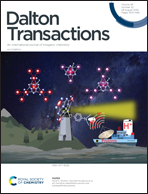Rational design of type I photosensitizers based on Ru(ii) complexes for effective photodynamic therapy under hypoxia†
Abstract
Photodynamic therapy (PDT) has been widely used in conjunction with molecular oxygen to cause cancer cell death. Hypoxia, the inherent property in solid tumors, is the obstacle during the process of PDT. It is urgent to develop PDT photosensitizers independent of the oxygen concentration. Herein, triphenylamine-modified Ru(II) complexes have been used as photosensitizers to produce superoxide anions (O2−˙) and hydroxyl radicals (˙OH) through a type I photochemical process. Ru(II) complexes with triphenylamine can provide a possibility to drive the reactive oxygen species production through low oxidation potential and good light-harvesting abilities. The investigation on light-mediated radical production showed that Ru4 could produce abundant ˙OH and O2−˙ compared to Ru1–Ru3 under hypoxic environments owing to the strong absorption. These radicals exhibit potent toxicity, which can damage the neighbouring biomolecules and cause the apoptosis of cancer cells. The PDT effect was evaluated in vitro under hypoxia, suggesting that Ru4 could maintain excellent performance in inducing a sharp decrease in the activity of cancer cells.

- This article is part of the themed collection: Spotlight Collection: Photoinduced redox chemistry


 Please wait while we load your content...
Please wait while we load your content...